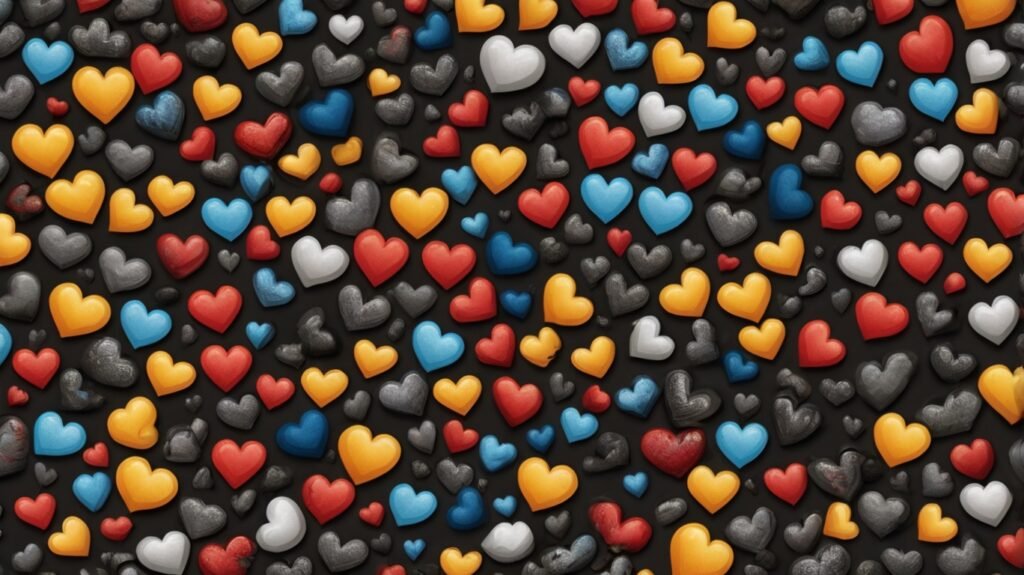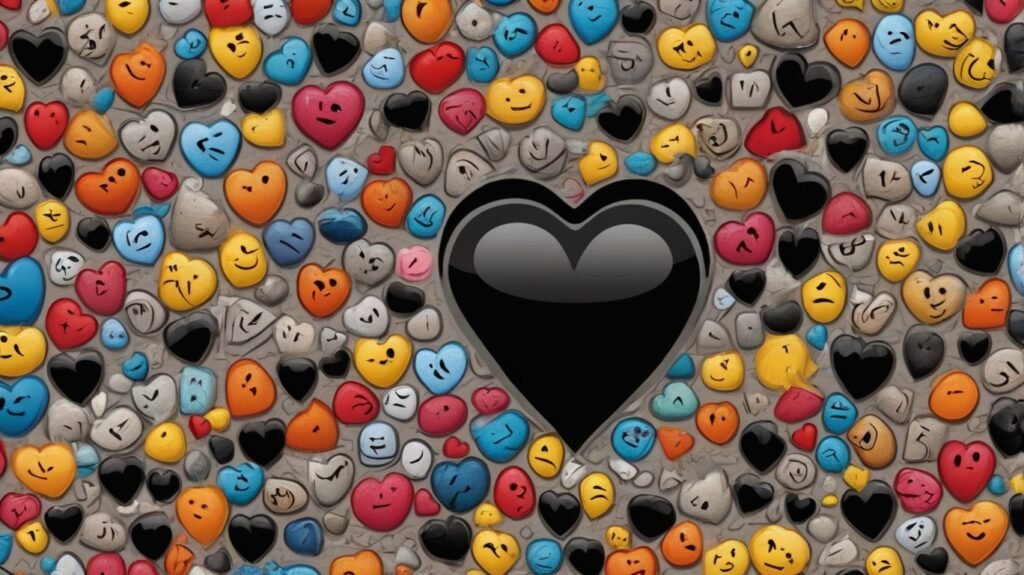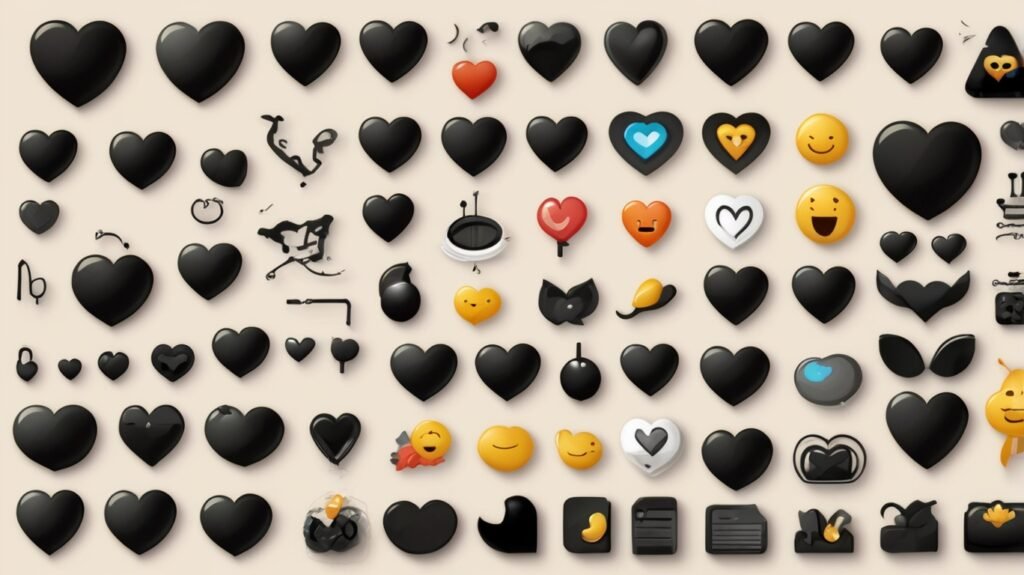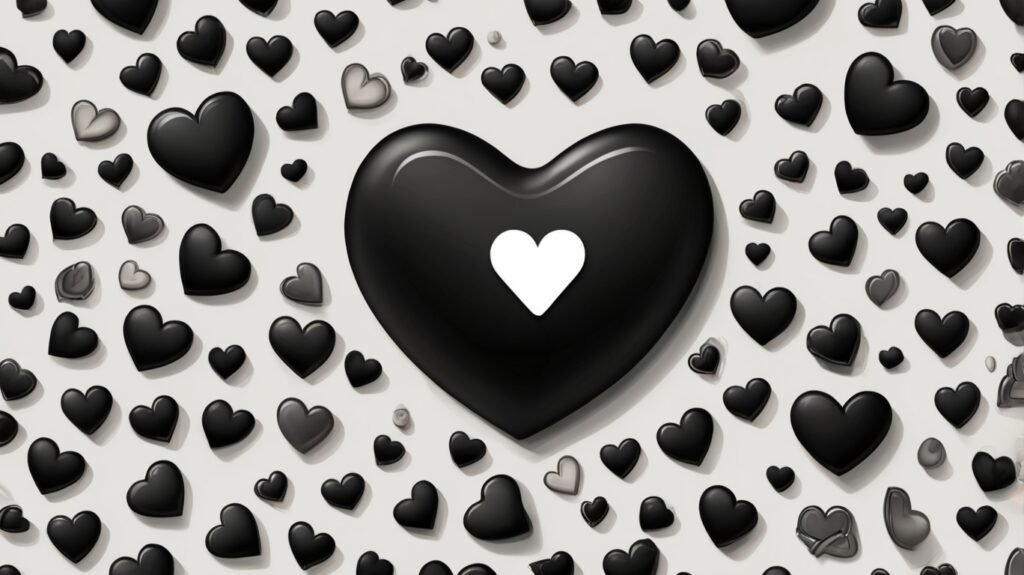Digital communication has transformed how we express emotions, and among the most intriguing symbols in our virtual vocabulary is the black heart emoji. According to the Pew Research Center, 92% of millennials use emojis on a daily basis, yet the black heart meaning remains one of the most misunderstood symbols in digital communication.
Unlike the universally recognized red heart that screams romance, the black heart carries layers of complexity that reflect our evolving relationship with digital expression. From gothic aesthetics to profound grief, from dark humor to social solidarity, this seemingly simple symbol has become a canvas for emotions that traditional hearts simply cannot capture.
This comprehensive guide explores every facet of black heart symbolism, providing you with the cultural literacy needed to navigate modern digital communication with confidence and authenticity.

The Psychology Behind Color Symbolism in Digital Communication
Understanding Black’s Dual Nature
Color psychology reveals that black simultaneously represents sophistication and mystery, power and mourning, elegance and rebellion. In digital spaces, these associations take on new dimensions as we adapt centuries-old color symbolism to screen-based interaction.
The black heart meaning emerges from this psychological complexity. Unlike physical objects where black absorbs light, digital black hearts create visual contrast that demands attention. Research in visual cognition shows that high-contrast symbols like black hearts process 13% faster than their colored counterparts, making them powerful tools for immediate emotional impact.
Digital Context Transforms Traditional Symbolism
Traditional black symbolism often carried negative connotations, mourning, death, or the unknown. However, digital communication has revolutionized these associations. The black heart emoji meaning now encompasses positive attributes like sophistication, artistic expression, and authentic emotion.
This transformation reflects broader cultural shifts toward embracing complexity in emotional expression. Studies show that 50% of emoji users use emojis that are different from their intended meaning, highlighting how digital symbols evolve beyond their original design purposes.

The Core Meanings of the Black Heart Emoji
Grief and Condolence Expression
The most universally understood black heart meaning relates to mourning and sympathy. According to Emojipedia, the black heart “may be used to express morbidity, sorrow, or a form of dark humor”, making it a powerful tool for expressing condolences in digital spaces.
When someone experiences loss, the black heart provides a visual acknowledgment that feels more appropriate than bright, cheerful alternatives. Consider these authentic usage examples:
Memorial contexts: Social media tributes to deceased loved ones Support messages: Acknowledging someone’s difficult time without minimizing their pain Collective mourning: Community responses to tragedies or public losses
The black heart’s effectiveness in grief communication stems from its visual weight. Unlike other heart colors that might seem inadequate or inappropriate during serious moments, black hearts carry the solemnity that matches the emotional gravity of loss.
Dark Humor and Ironic Commentary
Modern digital communication thrives on irony, and the black heart has become the perfect punctuation for sarcastic observations. This usage particularly resonates with younger generations who have mastered the art of digital irony.
Generational patterns show distinct differences in dark humor application:
- Millennials pioneered using black hearts for workplace frustrations and adulting struggles
- Gen Z expanded this to existential commentary and climate anxiety
- Gen Alpha is developing even more nuanced applications for digital storytelling
The black heart meaning in humorous contexts serves as a visual cue that signals “I’m being ironic” or “this situation is absurdly difficult.” It creates emotional distance while acknowledging genuine frustration, allowing users to process difficult experiences through humor.
Gothic and Alternative Identity Expression
The black heart emoji has become synonymous with alternative aesthetics, from traditional goth culture to modern dark academia movements. As Dictionary.com notes, “Far beyond the emotions of brooding artists, the Black Heart Emoji has become a symbol of compassion for friends, animals, and even movements.”
Subculture applications include:
- Gothic fashion: Complementing all-black outfit posts
- Dark academia: Emphasizing intellectual depth and classical aesthetics
- Alternative music: Supporting underground or emotionally intense artists
- Art communities: Representing creative passion and artistic authenticity
This usage transforms the black heart from a simple emoji into a badge of cultural identity. It signals membership in communities that value depth, authenticity, and non-mainstream expression.
Intense Romantic Love
While red hearts dominate romantic communication, black hearts express love that transcends conventional boundaries. This black heart meaning represents relationships that are complex, enduring, or unconventional.
Relationship contexts where black hearts thrive:
- Long-distance relationships: Acknowledging the difficulty while affirming commitment
- Complicated dynamics: Expressing love despite challenges
- Alternative relationship styles: Polyamory, age-gap relationships, or unconventional partnerships
- Mature love: Relationships that have weathered significant challenges
The psychological appeal of black hearts in romantic contexts lies in their authenticity. They acknowledge that real love isn’t always sunshine and roses, sometimes it’s choosing someone despite difficulties, or loving them through dark periods.
Social Justice and Solidarity
The black heart has evolved into a powerful symbol of social consciousness, particularly within movements advocating for racial equality and social justice. This usage demonstrates how emoji meanings can expand to encompass political and social significance.
Movement applications:
- Black Lives Matter: Supporting racial justice initiatives
- Mental health awareness: Acknowledging struggles while offering support
- LGBTQ+ solidarity: Showing support for marginalized communities
- Environmental activism: Expressing concern about climate change
Merriam-Webster recognizes that the black heart emoji is “often used to add emphasis in connection to things associated with black”, acknowledging its role in social and political communication.
This evolution showcases how digital symbols can transcend their original purpose to become tools for social change and community building.
Creative and Artistic Passion
Artists, writers, and creatives have adopted the black heart as a symbol of their craft, particularly when dealing with intense or challenging subject matter. This black heart meaning represents the depth and complexity of creative expression.
Creative applications include:
- Writing communities: Expressing passion for dark or complex narratives
- Visual artists: Representing exploration of difficult themes
- Musicians: Supporting emotionally intense or alternative music
- Content creators: Acknowledging the challenging aspects of creative work
The black heart resonates with creatives because it represents authenticity over commercial appeal. It signals that the work comes from a place of genuine emotion rather than surface-level entertainment.

Contextual Mastery: When and How to Use Black Hearts
Platform-Specific Guidelines
Different social media platforms have developed distinct cultures around black heart usage, and understanding these nuances is crucial for effective communication.
Instagram strategies: Fashion and aesthetic posts benefit from black hearts when showcasing monochromatic styles or alternative fashion. The visual consistency between black hearts and dark aesthetic content creates cohesive branding for influencers and artists.
Twitter applications: Political discourse and commentary frequently employ black hearts to signal serious intent or solidarity. The platform’s text-heavy format makes emoji choices particularly impactful for tone setting.
TikTok trends: Younger users integrate black hearts into storytelling and trend participation, often using them to signal emotional depth or alternative perspectives within popular formats.
Audience Consideration Matrix
Successful black heart usage requires understanding your audience’s cultural literacy and emotional context. Consider these factors:
Age demographics significantly impact interpretation:
- Baby Boomers: Often interpret black hearts literally as negative or concerning
- Gen X: Approach black hearts cautiously, preferring clear emotional context
- Millennials: Fluent in ironic and authentic applications
- Gen Z and Gen Alpha: Native understanding of complex emotional nuance
Cultural backgrounds also influence reception:
- Western cultures: Generally accept individual emotional expression
- Eastern cultures: May prefer subtler emotional indicators
- Religious communities: Might interpret black hearts as inappropriate or concerning
Timing and Frequency Best Practices
Like any powerful communication tool, black hearts lose impact when overused. Strategic deployment enhances their effectiveness:
Appropriate timing: Use black hearts when conventional options feel inadequate or when you want to signal emotional complexity. They work particularly well during significant life events, cultural moments, or when expressing support for serious causes.
Frequency guidelines: Limit black heart usage to maintain their impact. Users who employ them constantly may find their emotional communication becomes less effective as audiences adapt to their baseline usage.
Context switching: Alternate between black hearts and other emoji options to maintain communication variety. This prevents your digital personality from becoming one-dimensional while preserving the black heart’s power for moments when it truly fits.
Generational and Cultural Perspectives
Cross-Generational Usage Analysis
Understanding how different generations interpret and use black hearts is essential for effective cross-age communication in digital spaces.
Baby Boomers typically approach emojis with literal interpretation, often viewing black hearts as concerning or negative. When communicating with older relatives or colleagues, provide additional context or choose alternative expressions to avoid misunderstandings.
Generation X demonstrates cautious adoption of emoji communication, preferring clear emotional context over ambiguous symbols. They’re more likely to appreciate black hearts when used for obvious purposes like memorial posts or artistic expression.
Millennials pioneered many current black heart applications, from ironic commentary to authentic emotional expression. Their usage patterns established many of the contextual rules that younger generations inherited and expanded.
Generation Z demonstrates native fluency in black heart communication, creating increasingly sophisticated applications that blend humor, authenticity, and cultural commentary. Their innovations continue to shape how the symbol evolves.
Generation Alpha, though still developing their digital communication styles, shows early signs of even more nuanced emoji usage, potentially expanding black heart meanings in ways we haven’t yet anticipated.
Global Cultural Variations
Black heart interpretation varies significantly across cultures, reflecting different relationships with color symbolism and emotional expression.
Western cultural contexts generally embrace individual emotional expression, making black hearts acceptable for personal storytelling and identity expression. American and European users frequently employ them for ironic commentary and alternative aesthetic expression.
Eastern cultural perspectives may interpret black hearts more cautiously, particularly in cultures that prioritize collective harmony over individual expression. In these contexts, black hearts might be reserved for more serious applications like mourning or solidarity.
Regional communication styles also influence usage patterns. British users often employ black hearts for understated wit, while Australian audiences might use them for self-deprecating humor that aligns with cultural communication norms.
Avoiding Misinterpretation and Communication Failures
Common Misunderstanding Scenarios
Digital communication’s lack of vocal tone and body language makes emoji choice crucial for avoiding misunderstandings. Black hearts, due to their complex meanings, are particularly susceptible to misinterpretation.
Workplace communication requires special caution with black hearts. While they might feel appropriate for expressing frustration or solidarity with colleagues, professional contexts often lack the cultural context necessary for proper interpretation. Consider your company culture and relationship with recipients before using black hearts in work-related communication.
Family dynamics can create generational conflicts when black heart meanings aren’t shared across age groups. Younger family members using black hearts ironically or aesthetically might concern older relatives who interpret them as signs of depression or negative emotion.
Romantic relationships face unique challenges with black heart interpretation. Partners might misread black hearts as signals of relationship problems or emotional distance when they’re intended to express complex but positive emotions.
Digital Empathy and Emotional Intelligence
Developing digital empathy requires recognizing that emoji interpretation is highly personal and contextual. What feels obvious to you might be completely unclear to your recipient.
Recognition skills involve reading beyond the emoji to understand overall communication context. Look for additional clues in word choice, timing, and relationship history to accurately interpret black heart usage.
Response strategies should acknowledge uncertainty when you’re unsure about black heart meaning. It’s better to ask for clarification than to respond based on potentially incorrect assumptions.
Conflict resolution becomes necessary when black heart misunderstandings create relationship friction. Address misinterpretations directly and explain your intended meaning while acknowledging how your choice might have been received differently.
The Future of Emotional Expression Beyond the Black Heart
Emerging Trends in Digital Communication
As digital communication continues evolving, emoji usage patterns are becoming increasingly sophisticated. With 3,790 emojis now available in the Unicode Standard as of September 2024, users have unprecedented options for emotional expression.
The black heart’s role in this expanding ecosystem suggests several future developments:
Increased specificity: As emoji vocabularies grow, users may develop more precise applications for black hearts, reserving them for specific emotional contexts while adopting newer symbols for broader communication.
Cultural standardization: Global digital communication may lead to more standardized black heart interpretations, reducing cultural misunderstandings while potentially limiting creative applications.
Integration with emerging technologies: Voice messaging, augmented reality, and artificial intelligence will likely influence how visual symbols like black hearts function in future communication platforms.
Technology Integration and Evolution
Digital communication tools continue advancing, creating new contexts for emoji usage. Black hearts may find applications in:
Virtual and augmented reality environments where spatial communication creates new opportunities for emotional expression beyond traditional text-based platforms.
Artificial intelligence integration may help users understand emoji context better, reducing misinterpretations while potentially homogenizing creative usage patterns.
Voice messaging growth might reduce emoji usage overall, but black hearts may find new roles in hybrid communication that combines audio and visual elements.
Practical Application Guide
Quick Decision Framework
When deciding whether to use a black heart, consider this simple framework:
Purpose assessment: Does your message involve complex emotions that standard hearts can’t capture? Black hearts excel at expressing layered feelings or ironic commentary.
Audience evaluation: Will your recipients understand your intended meaning based on your relationship and their cultural context? Consider age, background, and communication history.
Platform appropriateness: Does the communication channel support the kind of nuanced expression that black hearts require? Formal platforms may not provide adequate context for proper interpretation.
Alternative options: Could other emojis or words express your meaning more clearly? Sometimes traditional hearts or descriptive language serves communication goals better than black hearts.
Professional Communication Guidelines
While black hearts can enhance personal communication, professional usage requires careful consideration:
Creative industries like advertising, design, and entertainment often embrace black hearts as part of brand personality and cultural communication. These fields typically have higher tolerance for expressive emoji usage.
Corporate environments generally require more conservative emoji choices, though black hearts might be appropriate for company communications about serious topics like social responsibility or employee support during difficult times.
Client communication should prioritize clarity over creativity unless your professional relationship specifically supports more expressive communication styles.
Mastering Nuanced Digital Expression
The black heart meaning encompasses far more than simple negativity or gothic aesthetics. It represents our evolution toward more sophisticated digital emotional expression, acknowledging that human feelings rarely fit into neat, colorful categories.
Understanding black heart symbolism requires recognizing its role in authentic communication. Unlike emojis designed for universal appeal, black hearts serve users who need to express complex, layered emotions that resist simple categorization.
As digital natives continue developing new applications for this versatile symbol, its meanings will undoubtedly continue expanding. The key to successful usage lies not in memorizing rigid definitions but in developing sensitivity to context, audience, and cultural nuance.
The black heart emoji stands as a testament to our collective desire for authentic expression in digital spaces. By mastering its various applications, from grief support to ironic commentary, from aesthetic expression to social solidarity, we enhance our ability to communicate genuinely in an increasingly connected world.
Whether you’re expressing sympathy, showcasing alternative style, or adding complexity to your romantic communications, the black heart offers a powerful tool for digital expression that honors the full spectrum of human emotion. Use it thoughtfully, contextually, and authentically, and it will serve as a bridge between the simplicity of digital communication and the complexity of human experience.
For more visit: https://prayersland.com/

Noah James is the author behind PrayersLand, a blog dedicated to inspiring faith, hope, and spiritual growth. With a deep passion for prayer and devotion, he shares heartfelt reflections, powerful prayers, and uplifting insights to strengthen believers on their spiritual journey. His writings aim to bring comfort, wisdom, and divine connection.

